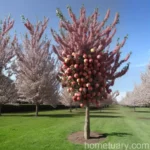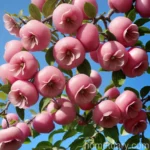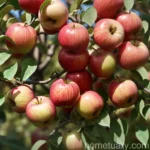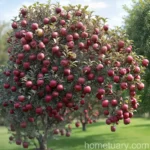Semi-Dwarf Apple (Malus pumila ‘Honeygold’): A Comprehensive Guide
In the world of fruit trees, the semi-dwarf apple (Malus pumila ‘Honeygold’) stands out as a popular and versatile choice for orchard enthusiasts and backyard gardeners alike. From its compact size to its delicious fruit and relative ease of care, this particular variety of apple tree holds a special place in the hearts of many. In this comprehensive guide, we will delve into the specifics of the semi-dwarf apple (Malus pumila ‘Honeygold’), exploring everything from its culture and uses to its maintenance, common diseases, and botanist’s tips.
What is the Semi-Dwarf Apple (Malus pumila ‘Honeygold’)?
The semi-dwarf apple (Malus pumila ‘Honeygold’) is a type of apple tree known for its compact size and delicious fruit. It is a member of the Rosaceae family and is a cultivated variety of the Malus pumila species, commonly known as the domestic apple. The ‘Honeygold’ cultivar is specifically prized for its golden-yellow apples, which are renowned for their sweet flavor and crisp texture.
Key Takeaways
Before we delve deeper into the various aspects of the semi-dwarf apple (Malus pumila ‘Honeygold’), let’s summarize some of its key features:
- Plant Name: Semi-Dwarf Apple (Malus pumila ‘Honeygold’)
- Size: Compact, semi-dwarf
- Fruit Type: Sweet, golden-yellow apples
- Uses: Culinary purposes, fresh eating, juicing, and more
- Cultivation: Ideal for home orchards, gardens, and containers
- Maintenance: Relatively low-maintenance with proper care
Now that we have an overview of this remarkable apple variety, let’s explore its various aspects in more detail.
Culture
Cultivating the semi-dwarf apple (Malus pumila ‘Honeygold’) involves understanding its specific cultural requirements, including water, sunlight, fertilizer, soil, and pruning.
Uses
The semi-dwarf apple (Malus pumila ‘Honeygold’) offers a multitude of uses, making it a versatile addition to any landscape or orchard. Some of its common uses include:
- Culinary Purposes: The golden-yellow apples produced by the ‘Honeygold’ cultivar are ideal for eating fresh, using in recipes, and making homemade applesauce, cider, and pies.
- Fresh Eating: The sweet, crisp texture of the fruit makes it a delightful snack for both children and adults.
- Juicing: The high sugar content and rich flavor of the apples make them an excellent choice for juicing.
Water
Proper watering is crucial for the successful cultivation of semi-dwarf apple trees. While these trees are more tolerant of dry conditions than their standard-sized counterparts, adequate and consistent watering is essential, particularly during periods of drought and in the early stages of growth.
Tip: When watering, ensure that the soil is moist but not waterlogged. Aim to water deeply, reaching the roots of the tree to encourage healthy growth.
Sunlight
Like most fruit-bearing plants, the semi-dwarf apple tree requires ample sunlight to thrive. When selecting a planting location, prioritize spots that receive full sunlight for the majority of the day. A minimum of 6-8 hours of direct sunlight is generally recommended for optimal fruit production.
Tip: In areas with scorching summers, providing some afternoon shade can be beneficial to prevent sunburn on the fruits and leaves.
Fertilizer
Fertilizing semi-dwarf apple trees is essential to ensure the tree has the necessary nutrients for healthy growth and bountiful fruit production. A balanced fertilizer with a higher ratio of nitrogen is typically recommended, especially for younger trees.
Tip: Consider soil testing to determine the exact nutrient requirements of your specific planting location. This will enable you to tailor the fertilizer application to the tree’s needs more accurately.
Soil
The soil composition plays a significant role in the overall health and productivity of semi-dwarf apple trees. Well-drained, loamy soil with a slightly acidic to neutral pH is generally preferred. Additionally, the soil should be rich in organic matter to support the tree’s nutritional needs.
Tip: A layer of organic mulch around the base of the tree can help retain soil moisture, regulate soil temperature, and suppress weed growth.
Pruning
Pruning is a critical aspect of semi-dwarf apple tree care, influencing the tree’s overall health, shape, and fruit production. It is important to understand the best practices for pruning this particular variety to maintain its compact size and encourage optimal fruiting.
Tip: Regularly remove dead, diseased, or crossing branches to promote air circulation and reduce the risk of pest and disease issues.
Propagation
Propagation of the semi-dwarf apple (Malus pumila ‘Honeygold’) is commonly achieved through grafting onto suitable rootstocks. This technique allows for the production of genetically identical trees, ensuring the preservation of the desired characteristics of the ‘Honeygold’ cultivar.
Container Popularity
The semi-dwarf nature of the ‘Honeygold’ apple tree makes it particularly well-suited for container cultivation. This trait has boosted its popularity among urban gardeners, patio growers, and individuals with limited outdoor space. When grown in containers, the tree can be moved to optimal locations for sunlight and protection from extreme weather conditions.
Tip: Select a large, sturdy container with adequate drainage holes to provide ample space for the tree’s roots and stability to withstand strong winds.
Common Diseases
Despite their relative resilience, semi-dwarf apple trees are susceptible to certain diseases that can impact their overall health and fruit production. Familiarizing yourself with these common ailments and their symptoms is essential for early detection and effective management.
Common Diseases of Semi-Dwarf Apple Trees:
| Disease | Description |
|---|---|
| Apple Scab | Fungal disease causing dark lesions on leaves and fruit |
| Cedar Apple Rust | Fungal infection leading to orange, gelatinous growths |
| Fire Blight | Bacterial disease characterized by wilting and blackening |
| Powdery Mildew | White powdery patches on leaves and shoots |
| Apple Canker | Sunken, dark lesions on branches and trunk |
Disease Diagnosis
Prompt diagnosis of diseases affecting semi-dwarf apple trees is crucial for implementing appropriate control measures. Physical examination, symptom identification, and, in some cases, laboratory tests can help identify the specific disease affecting the tree.
Diagnosing Tree Diseases:
- Visual Inspection: Check the leaves, fruits, and branches for any unusual spots, lesions, or growths. Document the appearance and locations of the symptoms.
- Laboratory Testing: If necessary, collect samples of affected plant parts for laboratory analysis to confirm the presence of specific pathogens.
Common Pests
Semi-dwarf apple trees are also vulnerable to attacks by various pests that can cause damage to the tree, foliage, and fruit. Understanding the behaviors and lifecycles of these pests is crucial for effective pest management and preserving the health of the tree.
Common Pests Affecting Semi-Dwarf Apple Trees:
- Apple Maggots
- Aphids
- Codling Moths
- Spider Mites
- Apple Sawflies
Understanding the distinct characteristics and habits of these pests will aid in their identification and control.
Botanist’s Tips
As a plant scientist with a deep appreciation for the semi-dwarf apple (Malus pumila ‘Honeygold’), I would like to share some expert tips to help enthusiasts cultivate and care for this remarkable fruit tree.
Tip 1: Prune Regularly
Regular pruning is vital for maintaining the size, shape, and health of semi-dwarf apple trees. Proper pruning encourages the development of strong, productive branches while removing any dead or crowded growth that can harbor pests and diseases.
Tip 2: Monitor Pest Activity
Regularly inspect your apple trees for signs of pest activity, such as chewed leaves, curled foliage, or blemished fruit. Monitoring early can help prevent pest populations from reaching damaging levels and protect your harvest.
Tip 3: Support Pollinators
Encouraging a diverse population of pollinators, such as bees and butterflies, can positively impact fruit set and overall yield. Consider planting pollinator-friendly flowers and herbs near your apple trees to attract and support these vital insects.
Fun Facts
Now, let’s explore some intriguing and delightful facts about the semi-dwarf apple (Malus pumila ‘Honeygold’):
- The origins of the ‘Honeygold’ cultivar can be traced back to the University of Minnesota, where it was developed to withstand harsh winter conditions while producing exceptional fruit.
- The compact size of the semi-dwarf apple tree makes it an excellent choice for urban and suburban landscapes, allowing individuals to enjoy homegrown fruit even in limited spaces.
- The golden-yellow apples of the ‘Honeygold’ variety are renowned for their exceptional sweetness, making them a favorite among apple enthusiasts and culinary artisans.
Links to External Resources
For further information on the topics discussed, as well as detailed guidance on caring for semi-dwarf apple (Malus pumila ‘Honeygold’) and other related fruit trees, explore these valuable external resources:
- Fruit Tree Pruning Techniques and Tips
- Apple Tree Care Guide – University of California Agriculture and Natural Resources
- Common Diseases of Fruit Trees – Penn State Extension
- Integrated Pest Management for Home Gardeners – University of California Statewide Integrated Pest Management Program
- Soil Testing and Fertilization Recommendations – The National Center for Appropriate Technology
In conclusion, the semi-dwarf apple (Malus pumila ‘Honeygold’) encapsulates the perfect blend of size, flavor, and manageability, making it an ideal choice for both novice and experienced fruit growers. With a firm understanding of its cultural needs, maintenance requirements, and potential challenges, cultivating and caring for the ‘Honeygold’ apple tree can be a rewarding and fruitful endeavor.
Through effective cultural practices, vigilant pest and disease management, and a touch of horticultural expertise, anyone can savor the sweet success of homegrown ‘Honeygold’ apples.
Remember, nurturing these remarkable fruit trees isn’t just about growing fruit – it’s about cultivating a connection to nature, savoring the joys of the harvest, and sowing the seeds of appreciation for our bountiful botanical world. Happy gardening!
By: Your Plant Scientist















